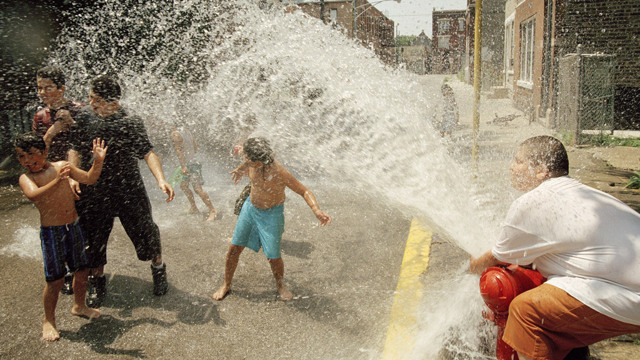July 20, 2022 2:05 pm
Creation of a headquarters to face the heat wave with professional nursing staff, increase of ambulances in service, opening of dozens of refreshment centers, agreement with taxi companies for transporting the elderly to cool places, hiring workers to do home visits.
Is it the French government’s plan to deal with the heatwave in July 2022? No, it’s that of the Mayor of Chicago at the end of July 1995 to protect its most vulnerable citizens from the heat. A few days of heat caused only two deaths in the US city. But two weeks earlier the rise in temperatures – up to 41 degrees during the day – had killed more than 700 in one week. That heat wave was one of the deadliest in US history.
26 years later, what are the indications given by the French government to protect itself from the impacts of temperatures that have reached unprecedented levels (40.5 degrees in Nantes and 41.7 in Biscarosse)? Observe “absolute vigilance”, “adopt the right behaviors”, such as staying cool, caring for the elderly and contacting a toll-free number, active only between 9 and 19. The Paris City Hall has also made rooms available refreshed and mobilized doctors to contact frail people.
But what happens to a person who lives too isolated? Or is she too weak to adopt the “right behaviors”? Shouldn’t public authorities be responsible for helping poor and isolated people, instead of asking them to adapt to the situation and have the right reactions? In Spain, a 60-year-old man died while sweeping the sidewalk in a temperature of 39 degrees. According to the Spanish health ministry, in the five-day heatwave, 360 people succumbed to the heat. In Portugal there were 569.
Abandoned neighborhoods have had more deaths
However, there are lessons to be learned from the 1995 Chicago tragedy, as demonstrated by US researcher Eric Klinenberg who has been studying this disaster for several years. His book Heat wave summer 1995: social autopsy of a disaster he wonders how it is possible that 739 people died from the heat in a large city in the richest country in the world, between July 14 and July 20, 1995.
It was the consequence of segregation and inequalities, but not only that, according to the sociologist. Eight of the ten neighborhoods with the highest death rates were populated almost exclusively by African Americans. These areas were also characterized by severe poverty and a high concentration of crime. In these neighborhoods lived many people who were completely isolated.
Chicago, July 17, 1995. The bodies of people who have died in the heat are loaded onto refrigerated trucks. (Charles Bennett, Ap/LaPresse)
“But that’s only part of the story,” notes Klinenberg, who compares the plight of residents of two sociologically similar neighborhoods on Chicago’s West Side: North Lawndale and South Lawndale. The first had 33 deaths per hundred thousand inhabitants and the second only three per hundred thousand. Why this difference? In urban areas where there were fewer deaths, the streets were lively, there were many shops that were always open, public facilities such as parks and libraries, and community life was active. This is what the sociologist calls “social infrastructure”, or the fabric that structures the life of a neighborhood.
On the contrary, the most affected neighborhoods were characterized by a high degree of neglect: closed shops, ruined factories, abandoned land used for drug trafficking, residents on the run. In the first case, you could walk to a restaurant or a grocery store. People knew the neighbors, they knew who lived alone, who was sick. The existence of a welcoming urban environment – Klinenberg speaks of “social ecology” – encouraged lonely people to go out on the streets and meet others regularly.
The death rate for African Americans was the highest among all population groups. This indicates a form of environmental racism
In the second case, the elderly remained closed in their homes. Disconnected from their families, they were also deprived of the chance to make friends. The victims were mainly elderly: 73 percent were over 65. In proportion, the death rate for African Americans was the highest among all population groups. This indicates a form of environmental racism, in which people usually discriminated against because of their belonging to a racial group also suffer the effects of particularly toxic environments.
Another lesson is chilling in retrospect: the city of Chicago and health authorities had initially relativized the health impact of that heat. It took all the stubbornness of a coroner, Edmund Donoghue, for the catastrophic increase in deaths to be attributed to the heat wave.
However, the mortality from these thermal events “was unprecedented in the history of heat waves in the United States.” And the images of corpses and refrigerated trucks had been shown in the media. But “no one could see what really happened to him.” For Klinenberg, “heat waves are silent and invisible killers of silent and invisible people.”
Heatwaves are what sociologist Marcel Mauss called “a totally social event”. That is to say, an event that brings social institutions into play and, consequently, lays bare a part of reality that is usually difficult to perceive.
After the July 1995 heat wave in Chicago, the bodies of 41 people were left abandoned. No one has ever claimed them. They ended up being buried in plywood boxes, in a single common grave.
(Translation by Stefania Mascetti)
This article appeared in the French online newspaper Mediapart.
